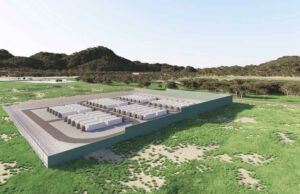Green Gravity has signed its second mine operator to its gravity-based energy storage technology, with contractor RUC agreeing to advise on the mineshaft aspect of the idea.
The partnership is a Memorandum of Understanding (MoU) and outlines a deal to adapt RUC’s knowledge of shaft sinking and mineshaft hoisting operations to accelerate and to improve the installation of the Green Gravity system into mineshafts.
The MoU comes as Green Gravity launches a $6 million capital raising round, which CEO and founder Mark Swinnerton kicked off last month in Singapore.
The company’s idea is to use excess renewable energy during the day to lift tens-of-tonnes steel coils to the top of a mine shaft. When energy is needed, such as the evening peaks, it lowers those weights to create kinetic energy and spin a regenerative electrical motor.
Green Gravity’s technology is similar to pumped hydro in that it uses gravity to generate power, but as yet it is untested at scale. It’s working with the University of Wollongong and Soto Engineering to develop the concept, and is now planning to lean on RUC’s industry and on-ground knowledge.
“Partnering with a leading organisation who sunk many of those shafts is an obvious choice,” Green Gravity CEO Mark Swinnerton said in a statement.
“The recent construction of the Gravity Lab in Port Kembla NSW has taken Green Gravity’s technology to the next level. Integrating the technical advancements of the electrical and control systems with the latest underground mining knowledge of RUC will lead to enhanced capability for our renewable energy technology.”
Swinnerton says commercial-scale designs are underway and Green Gravity plans to mine RUC’s experience for help on the vertical transit system and mine winder design — the equipment needed to get a load from the top of a mine shaft to the bottom, and vice versa.
“By re-using mining assets, costs can be kept low. By using gravity as the fuel, we dispense with consuming the critical water, land, and chemicals which other storage technologies rely on.”
Big names
Green Gravity has proved adept at signing up big names in the mining and resources sector to its cause, thanks to a management team hailing that has a collected experience working for the likes of BHP, Origin Energy, Bluescope Steel and BP.
It signed an MoU with engineering firm GHD in November and it has been supporting design work at the company’s first site, Yancoal’s Austar mine in NSW, and Bluescope Steel is a partner in the new Port Kembla Gravity Lab.
The company currently has 35 sites shortlisted for a commercial project in Illawarra, the Hunter region, Mt Isa in Queensland, and Tasmania, with a final investment decision on that due in late 2024.
The Austar study is modelling and doing geotechnical and hydrology work to prepare the site, which is on track to be finished this year. Originally this was the most likely site for a demonstration of the technology, but Swinnerton says they have a shortlist of three sites for the practical application of the tech.










